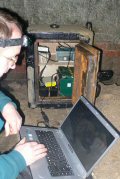Non Commercial Research
The New Forest Bechstein's & Barbastelle Research Project: We set this project up in 2005 through the Hampshire Bat Group to establish the distribution of these rare woodland bat species throughout the New Forest area. Secondary objectives are to involve and train local volunteers, raise awareness of bats amongst the general public, land managers, planning authorities and decision makers. Funding for equipment was provided by the New Forest National Park Sustainable Development Fund (SDF) & The New Forest Trust.
Monthly bat detector transects (survey routes) are walked by trained volunteers; bats are also captured and some are radio tracked so that roost sites can be located and given additional protection. Since 2005 we have found 4 Bechstein's and 3 barbastelle maternity colonies averaging 20-40 adult bats each. All capture and radio tracking surveys are supervised by ourselves as licence holders for the project and all data is shared with appropriate organisations. A number of training courses have been run for volunteers and talks for the general public.
In 2012 we recieved further funding from the SDF fund and New Forest Trust to establish four bat box survey sites in the New Forest. These will be monitored twice a year and any target species ringed. The New Forest National Park have also provided funding to undertake DNA analysis of long-eared bat droppings found in bat boxes (as well as properties surveyed by the group). These will help us to survey the area for the rarer species of grey long-eared bat.
Research into the Swarming & Hibernation Behaviour at Greywell Tunnel: Greywell Tunnel is a disused canal tunnel near Basingstoke, Hampshire. It is a Site of Special Scientific Interest (SSSI) and supports the second highest winter population of Natterer's bats in Europe. Paul has been studying swarming and hibernation behaviour of bats at Greywell Tunnel since 1992 and undertook a study of the hibernal ecology of vesper bats for his PhD, basing much of his study on bats using Greywell Tunnel.
Data loggers record temperature and humidity; Anabat detectors and passive infra-red beams record bat activity levels. Thermistor radio tags are used to monitor bouts of torpor. Other aspects of study include analysis of feeding remains in bat droppings collected in the tunnel, video monitoring, winter bat detector transects and invertebrate sampling.































